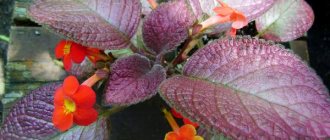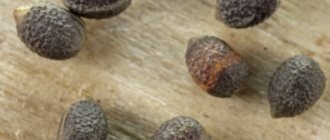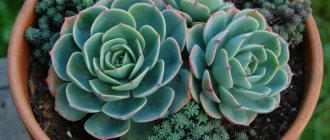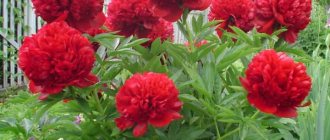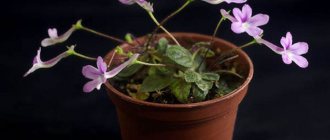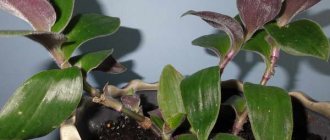Features of Zamioculcas
A special feature of Zamioculcas is that the leaves are the entire aerial part, and not each leaf separately, as many people think. It consists of several plates located on the handle.
Unlike other tropicals that live in apartment conditions, this plant is not whimsical - it grows well in the heat, in a cold room - of course, you need to observe moderation. The only thing the flower cannot tolerate is excess watering in a cool room. The roots may begin to rot; the zamioculcas will need to be urgently rescued and replanted.
The plant can survive in any soil, so it does not need to select anything special. To create conditions for full growth, it is enough to place the flower on a lighted windowsill, but shade it from the sun's rays so that they do not damage the leaves.
Carefully! Zamioculcas is very poisonous - alkaloids are contained in all its parts - aboveground and underground, so any manipulations are carried out with gloves.
How to Propagate a Dollar Tree Using Leaves
For propagation, leaves taken from an adult plant are used. The algorithm is as follows:
- The leaves are cut off and left to dry (60 minutes is enough);
- The cut area is treated with a development stimulator - Kornevin;
- Planting material is placed in enriched soil;
- After 72 hours, the soil is watered by drip, and the leaves are sprayed with water.
It remains to wait a few months until roots begin to appear on the foliage. This will take a quarter at most.
The dollar tree is characterized by slow development. New sheets may appear only after six months.
Reproduction in a container of water
The essence of the technique is to place the leaves or shoots of an adult plant in containers with water. This is how the future root system will be formed. The lower area of the leaf is treated with a growth stimulator. The following active substances are suitable for this: Rhizomes, as well as Zircon or Heteroauxin.
Propagation of plants from cuttings
This planting option is used most often. Shoots of adult plants are used. Young leaves, due to the unformed plate, are not suitable for propagation. In addition, they contain an insufficient concentration of nutrients, without which it will not be possible to grow a full-fledged plant from shoots.
Popular: What to do when rehabilitating the roots of a cactus when rotting
Paying attention to the fact that the use of cuttings does not always lead to a good result, it is possible to plant Zamioculcas trees directly in plastic pots, without creating a greenhouse effect. Dilution takes place according to the following sequence:
- A shoot of an adult plant with well-developed leaves is used;
- The selected shoot is divided into separate zones so that each has at least two leaf plates;
- The cutting that is used from the upper region of the shoot can grow three new leaves. After cutting, the planting material should be left in the air for up to three hours. Rushing it into the soil right away is not recommended. In this case, due to increased humidity, the cuttings may die;
- The tips of the shoots are dipped in a stimulating solution for the formation of roots - the active substances of Zircon or Kornevin. This product is a protection against insects;
- A universal soil is prepared for replanting. It must include hydromica minerals. This component makes the soil porous. To make the shoot take root faster, the plant is placed in a microgreenhouse by covering it with plastic film;
- The first watering and loosening of the soil takes place after 72 hours. A spray bottle is used for watering. After two months, new tubers with roots will appear on the shoots. In six months the first leaves will grow.
Propagation by dollar tree tubers
This propagation method will be ideal for transplantation. Zamioculcas is divided into individual tubers, from which new bushes can be formed.
Using tubers for propagation is the simplest of the options described. It is necessary to carefully separate them into separate parts. But caution here will not be superfluous, because the main thing is not to injure the root cone. When the plant separates, all components must be kept in the air for several hours. Sections of sections are treated with sorbent. Watering is carried out only after 72 hours. It is not the soil that is moistened, but only the leaves.
Propagation by small leaves
For propagation, it is important to prepare in advance small leaves obtained from a developed shoot of the plant. Before the procedure, the planting material is kept for several minutes without water on the windowsill so that the cut area becomes covered with a crust. It is then treated with a growth activator to develop a strong root.
To accelerate growth, an algorithm is used:
- The area of planting material located below is placed in moist soil with sand and peat additives;
- On top, the future cutting is covered with a bag to maintain the temperature and create a humid environment;
- Before minor shoots appear, the plastic bag is removed daily to allow oxygen to enter.
Popular: How to recognize and protect rotting orchid roots
Breeding is allowed without creating a greenhouse effect. To activate the growth of planting material, universal soil is used, which is rational to purchase in the dacha section of the supermarket. It is important to choose a composition based on peat/sand.
Breeding rules
Zamioculcas grows slowly, so adult crops are rarely replanted. It is necessary to select the right pot so that its size exceeds the previous one by no more than 2 cm. If you plant it in a large one, all the energy will go into root growth, while the leaves will stop developing.
The peculiarity of the dollar tree is that its root system stops growing when it touches the edge of the pot. After this, foliage begins to develop.
To get a lot of small zamioculcas, reproduction at home can be done in any way:
- whole cuttings;
- separate leaves;
- dividing a root or bush.
The main condition for the reproduction of a dollar tree is a healthy plant. You cannot take leaves damaged by rot - they will not take root and the soil will be contaminated. Parts of the flower take root in water, peat, and sand.
Important ! The smaller the rooted part, the longer you will have to wait for a full-fledged plant. In general, the process takes about 6 months.
Care after landing
Caring for cuttings is simple and requires the fulfillment of a number of conditions:
- Warm (22-25 °C) humid (from 70%) air.
- Place the seedlings in a bright place.
- Daily ventilation.
- Starting from 3-4 days after planting, moderate watering (preferably from a spray bottle) using a solution of any biostimulant.
The temperature for the growth of young zamioculcas should not fall below 20ºС. At the same time, the life processes of the plant slow down greatly, the flower stops growing. It is better to keep the sprouts warm with a temperature of about 25ºС. They also do not tolerate heat above 30ºC.
While zamioculcas sprouts are still very small, they need to be kept in diffused light. Even exposure to direct sun in the morning can lead to the formation of burns on the tender leaves of the sprouts.
Soil selection
For aroids and succulents, the soil should be light and well-permeable to air. Heavy soil mixed with clay will slow down the growth of the root system and can lead to rotting. Clay or too oily soil retains water well, preventing the roots from breathing.
To properly compose the soil mixture, you need to take more sand and peat, for example, 2 - 3 parts of both. The remaining components - garden soil and turf - are taken in smaller proportions. The optimal ratio is:
- peat 2 parts;
- sand 2;
- turf soil 1 part;
- leaf humus 1.
You can add 0.5 parts of mullein humus for nutritional value, but this is not necessary. To prevent rotting, it is recommended to mix perlite into the soil and add pieces of charcoal.
Important ! Drainage must be laid at the bottom. In case of overflow, there will be air left for breathing and the flower will not get sick.
Mistakes that can be made
- The most common mistake that will lead to damage to Zamioculcas and the proliferation of pests is excessive watering;
- Zamioculcas also needs constant sunlight;
- It is better for the gardener to plant the crop, otherwise the main plant may be ruined and new shoots may not be obtained.
Zamioculcas is rarely exposed to pests, and diseases are even less common. This arises directly from illiterate care, or more precisely, from abundant enrichment with moisture. This causes the root system to rot. The remaining roots are separated from the rotten parts and sprinkled with activated carbon.
Yellow foliage indicates the presence of pests. The bad parts are cleared away until new greenery begins to grow. The appearance of yellow leaves can be caused by:
- Temperature changes;
- Through flow of cold air;
- Poor quality watering;
- Fungal infection.
Popular: What to do if the leaves of the calathea begin to turn yellow
Yellow foliage on a plant may also appear for seasonal reasons. Most often this happens due to the active growth of young shoots. Therefore, if yellow leaves appear on old branches, but new shoots are growing at the same time, you should not worry.
Methods of propagation of Zamioculcas
When Zamioculcas reproduces by leaf, the process of formation of a root and a small tuber occurs due to the supply of nutrients found in the leaf blade. When this supply is exhausted, the planting material turns yellow. There is no need to throw away the cutting at this moment - this is exactly how the dollar tree reproduces. After some time, a new leaf appears above the soil surface.
The same thing happens if you cut a tuber. The appearance of the above-ground part is due to the nutrients stored by the plant.
In order for the transplantation of a dollar tree to be successful, they stock up on fungicide and activated carbon in advance to disinfect the roots. They are delicate and can easily break if handled carelessly. To prevent bacteria and fungus from getting into the wound, they are dried after separation and treated with chemicals.
Cuttings or branches in the ground and in water
It is easier to propagate with a whole cutting, which has many leaf blades and growing points. A large specimen contains a larger supply of minerals, so it takes root more successfully and faster. If the old zamioculcas has grown greatly, propagation by a branch will be the best way for it for the following reasons:
- you can get several large copies at once;
- randomly fallen leaves are also rooted so that flowers will grow from them later;
- the culture rejuvenates and begins to grow again, like a new plant.
True, in this case it is necessary to injure the plant, after which it takes longer to recover and remains in the pot without signs of growth.
Potassium humate or another rooting agent can be added to the water to speed up the root formation process. It is best to root Zamioculcas when propagating by cuttings in May. At this time, the daylight hours are long, the plant has enough light to synthesize chlorophyll.
Without water, immediately in the ground, Zamioculcas also takes root well. The main thing is that the soil is moist, but not flooded. Water the cuttings along the edge of the pot, the moisture then rises in the form of steam through the layers of soil and the roots can breathe.
With this method of propagation, a tuber appears in about a month and a half. He is small and delicate, so you don’t need to touch him for 6 months. Transplantation is carried out when the roots have outgrown the volume of the pot and appear from the drainage holes.
Leaf propagation
You can use a less traumatic method for zamioculcas - leaf propagation:
- To do this, not the entire cutting, but 1–2 leaf plates are cut off with a knife close to the branch.
- Place the leaf in water with a rooting agent and shade it.
- Periodically spray and ventilate. You can put on a transparent bag or make a greenhouse out of film.
The soil is taken loose. Just sand, pre-calcined in the oven, will do, but it is better to mix it with peat 1:1 for greater nutritional value. Although, while the leaf does not have a root system, it will not be able to feed from the soil - this is for the future.
There is no need to overwater or spray the cuttings heavily. The soil must be permeable to air - this is the main condition for the successful reproduction of zamioculcas. If the growth of the cutting stops - its height has not changed in several days, then you need to check the soil for moisture. Perhaps the grower overdid it and did not add water, for fear of rotting.
Dividing the bush
If the time has come to replant the dollar tree, propagation at home can be combined with this procedure. An adult Zamioculcas may have several tubers in the soil and large feathery leaves and branches growing from them. To decide how to divide the zamioculcas bush, it is taken out of the pot and inspected. Most often, all the roots turn out to be intertwined; they will have to be carefully untangled in order to reduce injury. The tubers are in the center, close to each other. They are connected by a small thin bridge, which is cut with a knife and rubbed with fungicide.
Procedure:
Get a flower.
- Check that each tuber has a growing point - a branch or bud. Otherwise, the tuber without a bud may die.
- Carefully cut off the parts that represent individual root systems.
- Unravel the roots.
- Treat cuts and breaks with fungicide and leave to dry for 5 – 6 hours.
- Prepare the soil and lay drainage.
- Plant zamioculcas in the soil so as not to deepen the root collar too much.
Next, the flowers are placed in a bright place without direct sunlight. Over the next 4 to 5 months, the plants will adapt and take root.
Tuber division
The tuber that has several growth points - green buds - is suitable for division. If there is only one growth point, the underground part is not divided, since it will not be able to develop and will rot.
If the flower meets all the parameters, for example, there are three growth points, a tool is prepared - a sharp knife and activated carbon. Before manipulation, you must wear gloves and protect your eyes.
How to do it:
- Cut the rhizome as planned.
- Treat with activated carbon or fungicide.
- Leave the sections to dry for 3 – 4 hours.
- During this time, prepare a damp substrate and place it in a pot with large drainage holes.
- Replant the divisions.
The leaf embryo must be above ground level in order to begin to develop and produce chlorophyll.
Planting sheets in the ground
Zamioculcas leaves rooted and planted in the ground are kept in a greenhouse until sprouts appear. All this time, they maintain the necessary soil moisture in the pot. The soil should not be over-moistened, as this quickly leads to rotting and death of the rooted leaf of the plant.
The greenhouse with rooted leaves is opened daily for 20-30 minutes. for ventilation. Cuttings and leaf blades also need to be ventilated every day. Glass jars or film are removed from them to reduce condensation.
The temperature for the formation of sprouts should be within 20-25ºС, but can reach up to 30ºС.
Under these conditions, small sprouts appear from the ground at the base of the leaf. The film is not removed from the shoots immediately, as they need to be gradually accustomed to the air humidity in a city apartment. When the sprouts are already fully open and accustomed to growing indoors, they can be transplanted into soil for zamioculcas.
Store-bought succulent soil is best suited for these plants.
Young plants are replanted with partial removal of old soil. The flower is removed from the old pot, the peat soil is lightly shaken off the roots and transplanted into a new pot with fresh soil. Do not expose the roots too much and do not remove all the soil.
Caring for a young plant
At the first stage of growth, immediately after transplantation, Zamioculcas will not grow. He needs time to get used to the new soil. You can help the plant by creating favorable conditions. These are temperature conditions, light and watering. Immediately after reproduction, zamioculcas is not fed - all the nutrients are in the soil.
Temperature
The optimal temperature in summer during the active growing season will be 22 - 25 degrees. Humidity is moderate. In preparation for wintering in the fall, the plant is transferred to a cool room with a temperature of 16 - 18 degrees. The flower is not afraid of drafts, but the room must be ventilated often - every day.
Lighting
Thick leathery leaves can get burned if the plant is exposed to the sun without gradually acclimating. The most suitable place for Zamioculcas is a south-eastern window or a southern window behind a curtain or blinds. On the north side the flower will feel worse due to lack of light.
Watering
You need to water on demand: if the soil is dry, add water, draining the rest of the tray. It is necessary that there is air between the roots and the bottom of the pot, then the roots will not rot. Water carefully in winter if the room is cool. In this case, it is better to wait until the soil is completely dry and then water.
In summer, the soil should not be allowed to dry out completely - this leads to yellowing of the foliage and its falling off. Also, the flower will grow poorly without moisture, consuming it from tuber reserves. It is dangerous to propagate a weakened plant - it may not survive the procedure.
Feeding
Fertilizers can be applied from the beginning of the growing season - in the spring. Until autumn, water with a nutrient solution twice a month. Old plants, which are rarely replanted, especially need minerals, since they take all their nutrition from the soil to grow.
In winter, do not feed zimioculcas - this can cause harm. Fertilizers are purchased for succulents or cacti. The plant absorbs nutrients better in sunny weather. If it is rainy and cloudy, it is better to postpone watering.
Formation
Old leaves naturally dry out as they grow. To prevent them from drawing nutrients from young branches, old ones are cut off. You also need to remove yellowed leaves - they contain fungal spores that can infect the entire bush.
To prevent long branches from breaking, it is recommended to provide a support and secure the flower with plastic rods. Zamioculcas grows symmetrically, as far as old branches are concerned. It is capable of forming its own crown, so pruning complex green leaves is not necessary. If this is done, you can root the cuttings to grow new plants.
Transfer
Young plants need replanting while their root system is growing and green mass is growing. When the dollar tree reaches its maximum and growth needs to be slowed down, it is not replanted, since the root receives a stimulus to grow, and the leaves follow it.
The signal for replanting is that the roots fall out from below through the drainage holes.
Possible problems
- Young zamioculcas show signs of infectious diseases . To prevent this phenomenon, it is recommended to disinfect the soil and the pot in which the cuttings will be planted (fungicide treatment, heat treatment).
- Rotting of cuttings . This phenomenon is possible with excessive watering. Also, one should not forget about daily ventilation of the “greenhouses” in which the plant is rooted.
- The cuttings do not take root in water . It is possible that the cut has dried out. It is enough to remove the petiole from the water and renew the cut. And also make sure that the shoot is not exposed to direct sunlight.
Cuttings are the optimal way to propagate zamioculcas, which does not require special skills or time. In this way, you can constantly extend the life of the plant you like, as well as multiply the number of specimens of the spectacular succulent.
Pruning and replanting
The plant is pruned if they want to give the bush a certain shape or a thick crown.
Damaged or dried branches should also be removed. Especially if the cause was a disease.
Transplantation time depends on the age of the plant
Young zamioculcas are replanted once a year, adults - once every 2-3 years.
Technology:
- Choose a pot 2-3 cm larger in diameter than the previous one.
- Coarse drainage (clay shards, expanded clay) is laid on the bottom. Then a finer baking powder (vermiculite, gravel). The next layer is soil mixed with foam and perlite.
- The plant is removed from the pot and simply transferred to a new container as a whole. The roots are not shaken off or separated.
Such a transplant is the least traumatic for the flower.
Description of the species
The plant received its popular name “dollar tree” due to its glossy and beautiful leaves. One fleshy stem contains up to 10 leaves. Thanks to the root system, which is adapted to store water, the tree tolerates the summer season well. The anatomical and morphological properties are in many ways similar to the familiar “money tree”.
With proper care, the plant can reach a height of up to one meter. Zamioculcas rarely blooms, which is primarily due to our climate. Well, if the owner managed to please all the arrivals of the plant, then at the exit he can see a yellow flower that reaches a diameter of 10 centimeters.
If you are aiming to see flowering, then you must follow some rules, namely:
- Timely watering
- Sufficient lighting
- Maintaining temperature (20-25 degrees Celsius)
The dollar tree grows quite slowly. But in general, I would like to note that caring for the plant is not difficult, and even a beginner in the flower business can do it. Since Zamioculcas is a succulent, the plant loves: moderate humidity, timely watering, and supplements with microelements, based on potassium and fluorine.
An adult plant is not cheap. That is why everyone who wants to grow a tree on their own asks the question: is it possible to grow it from a leaf? Get a couple of leaves of the plant, be patient and start planting the leaf in the soil.
Advice for beginners
Zamioculcas will delight the owner with lush green leaves for many years, if you follow the advice of experienced gardeners:
- Water the flower only with purified or settled water at room temperature.
- The pot should be placed in a well-lit room. Windows on the west or east side are ideal for its placement.
- During the period of active growth - spring and summer, Zamioculcas needs feeding.
- For adult plants, you will need support so that the bush does not fall over.
- At least once a month it is necessary to remove dust from the leaves using a soft damp cloth or cotton pads.
- To prevent leaves from becoming discolored in winter due to lack of sunlight, it is recommended to use a phytolamp.
- Do not leave an exotic plant in direct sunlight.
If desired, even a novice gardener can successfully propagate Zamioculcas. The easiest ways to get new plants are cuttings and leaf rooting. To achieve success in growing succulents, it is important to properly care for young seedlings, protect them from temperature changes and pests, and prevent the soil from becoming waterlogged.

